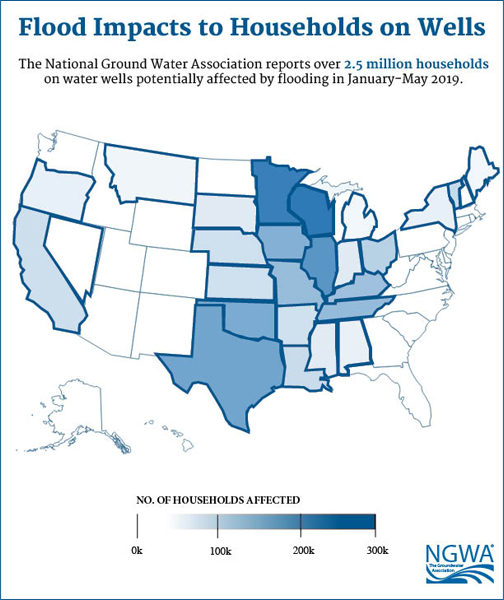Exposure to E. Coli and Coliform Possible in Flooded Locations
According to the National Ground Water Association (NGWA), wells supplying water to over 2.5 million households may have been flooded in 28 states and the Navajo Nation during the series of January-to-May 2019 storms. The household count includes those on domestic wells in 835 flooded counties across the United States, per Census Bureau data*. The states are primarily in the central and southern regions of the United States from Minnesota to Texas but also include California, Oregon and New Hampshire.

The Association says that based on the results of an earlier detailed study of wells flooded by Hurricane Floyd in 1999 in ten North Carolina counties, the number of domestic wells potentially affected by floodwater in the flooded counties may be as many as 10 percent of the number of well-water-supplied households** in the counties experiencing flooding***. These figures, based on one study, are not statistically representative but give an approximation of wells potentially affected by flood events. In this case, a worst-case estimate of up to 250,000 domestic wells across the country may have been affected by flood events over the first five months of 2019. An exact number of wells actually flooded is difficult to determine without extensive field observation over large areas. The well location relative to surface water bodies, topography of the ground surface, geology associated with the wells, duration of rainfall contributing to flooding, and soil moisture conditions prior to flooding will also affect the number of wells impacted.
Of greatest concern is the possibility of well contamination from floodwaters carrying pathogens and chemicals. Exposure to E. coli, coliform, and other pathogenic microbes from human and animal fecal matter may occur following a major flooding event. Household, farm, and small business wells situated in the broad rolling countryside and near streams and ponds could be standing in water for several days, raising potential health concerns if the well isn’t properly maintained. In the 1999, 2016 and 2018 flooding of eastern North Carolina counties and also the current 2019 flooding across Nebraska, laboratory testing documented 17%, 27%, 45% and 24%, respectively, of samples from domestic wells tested positive for fecal contamination.
Principal concerns about well conditions affected by high water are that wells having wellheads that are cracked or faulty or have been damaged by flood debris may allow contaminated floodwater into the well. “A third concern is that with rainfall extending over several weeks, the ground may be saturated with water, and septic system wastewater can be drawn into nearby wells,” said Chuck Job, NGWA regulatory affairs manager who compiled this data.
“Ideally, wells should be inspected annually by a water well systems professional to make sure they are in good condition to minimize potential impacts and other water-quality issues,” said Bill Alley, NGWA director of science and technology.
“If contamination is suspected however,” adds David Henrich, Minnesota Water Well Association president, NGWA past president, “it is important to get the well tested as soon as it is safe to do so. Using certified professionals will ensure that your well system is returned to its pre flood condition and is safe to use.”
NGWA previously reported on flooding in the Midwest in March 2019. At that time, 1.1 million households served by domestic wells resided in over 300 counties affected by flooding in ten Midwestern states. Those households and counties are included in the figures reported above.
NGWA offers a flooding resource center at WellOwner.org. Within this site, well owners can connect to certified contractors in their respective communities nationwide, as well as gain knowledge on how to test, tend and treat well systems, before and after a flooding event.
Households with Wells Potentially Affected in 28 States and Tribe with Flooding in 835 Counties
|
|
|
|
Alabama
|
29,165
|
|
|
Arkansas
|
63,720
|
|
|
California
|
67,577
|
|
|
Illinois
|
223,937
|
|
|
Indiana
|
41,553
|
|
|
Iowa
|
167,137
|
|
|
Kansas
|
66,221
|
|
|
Kentucky
|
131,473
|
|
|
Louisiana
|
75,567
|
|
|
Maine
|
18,676
|
|
|
Michigan
|
19,313
|
|
|
Minnesota
|
265,856
|
|
|
Mississippi
|
39,453
|
|
|
Missouri
|
140,767
|
|
|
Montana
|
21,881
|
|
|
Nebraska
|
99,371
|
|
|
Nevada
|
1,794
|
|
|
New Hampshire
|
4,568
|
|
|
New York
|
32,110
|
|
|
North Dakota
|
1,430
|
|
|
Ohio
|
97,098
|
|
|
Oklahoma
|
177,082
|
|
|
Oregon
|
32,129
|
|
|
South Dakota
|
40,925
|
|
|
Tennessee
|
142,096
|
|
|
Texas
|
189,235
|
|
|
Vermont
|
76,464
|
|
|
Wisconsin
|
281,141
|
|
|
Navajo Nation
|
12,239
|
|
|
|
|
a State numbers of households may include tribes
Sources: Online Federal and State hazardous weather and flood reports; Federal and State disaster declarations; and online local news reports
* Based on last census with representative results for household water sources outside metropolitan areas nation-wide: 1990 American Housing Survey.
** In some cases, a domestic well may supply more than one household.
** National Ground Water Association. 2002. Field Evaluation of Emergency Well Disinfection for Contamination Events; Final Project Report for U.S. Federal Emergency Management Agency, Washington, DC.
--------------------------------------------------------------------------------------------------------------
NGWA is the leading organization of professionals committed to the management, protection, and use of groundwater resources.
National Ground Water Association: 601 Dempsey Road, Westerville, Ohio 43081-8978 USA
phone (614) 898-7791, toll-free (800) 551-7379, fax (614) 898-7786, email ngwa@ngwa.org
XXX